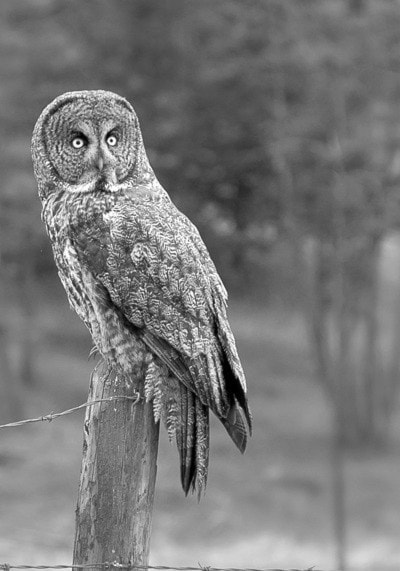There are those people who call themselves wildlife, bird, or landscape photographers, and who spend their time hunting, hiking, and searching to make their pictures. Those hunters go after their subjects spending hours and even days in their quest to get pictures of birds, animals, and scenes, while hiding, crouching and waiting for the perfect shot. And then there are those that I’ll call “roadside photographers”. The roadside photographer just gets lucky.
I have written about both wildlife and bird photographers in the past, but what does it take to be a roadside photographer? Well, to begin with, a camera must be in the car. One cannot take pictures without an easily accessible camera. Next, and in my opinion very important, is a spouse with sharp eyes that will yell, “Stop! There’s an owl,” or “Look at that stream.” And finally the ability to slam on the brakes and stop the car, and the willingness to put that cup of coffee in the cup holder, wait a moment or so, then either get out and hide behind the fender or slowly drive forward while aiming the camera and releasing the shutter continually.
The “RSP” (I’ll call them that for short.) must be prepared and ready at a moment’s notice to grab the camera from its bag on the back seat, roll down the window (that’s a must), take a quick exposure reading, and shoot.
Zoom lenses are best because fixed focal length (prime) lenses aren’t versatile enough and changing lenses is just a hassle while sitting in the driver’s seat. I advise an 18-200mm, however, 55-200mm or 70-300mm might also be good choices, but one never knows when a wide angle will come in handy, and the option of at least 200mm is also a must to fill the frame and bring any subjects closer that are some distance away.
Metering the exposure is a very important factor for effective roadside photography. Placing the camera mode on P (program) mode reduces the number of keepers dramatically and my advice would be to ignore those point-and-shooter modes completely. I suggest using either “A” (aperture priority) where one selects the aperture and allows the camera to choose the shutterspeed, or as I do, select “M” (manual exposure mode) where I select the shutterspeed to reduce camera shake, then choose the smallest aperture my meter will let me have.
This kind of photography doesn’t always have the luxury of time to attach a tripod to the camera base, a beanbag might work though, but only if one has the presence of mind to pull it from beneath the seat and slap it down on the window opening. Nevertheless, the RSP needs to quickly and accurately meter, shoot fast, and be ready for other cars that slowly pass as people try to see why the car is stopped. One must not loose composure by madly waving or yelling, “Go, go, go!” but ignore them and be calm, as that car will pass and hopefully won’t ruin the shot. The light isn’t always optimal, and the perspective and angle of the shot is going to depend on the road and the placement of the vehicle in relationship to the subject to be photographed. There are those roadside shooters that point and shoot, but the serious roadside photographer is equipped with a DSLR, the skill to use it effectively, and experience to understand how to work with restricting conditions.
Unlike dedicated wildlife or scenic photographers, the RSP doesn’t just go out to photograph a particular subject and returns home when that has been accomplished.
Much of the time the RSP, skilled multi-taskers that they are, will be involved in other activities like going to work, visiting friends, or making that run to the store before supper, yet still are on the lookout for any kind of subject to photograph, and some roadside photographers are quite silent about how the wonderful picture they are showing was made by chance, and from behind the steering wheel of their car. It sounds so much better for viewers to think the picture was made after some lengthy excursion on foot.
There are a growing number of skilled roadside photographers that are safely driving to their final destination and who are always ready and watching for a photographic opportunity.
These are my thoughts for this week. Please don’t hesitate to contact me. Email your comments and suggestions to me at emcam@telus.net or phone 250-371-3069
John Enman owns and operates Enman’s Camera at 423 Tranquille Road in Kamloops, selling an interesting selection of used photographic equipment and offers professional wedding and event photography. Check out www.enmanscamera.com.
